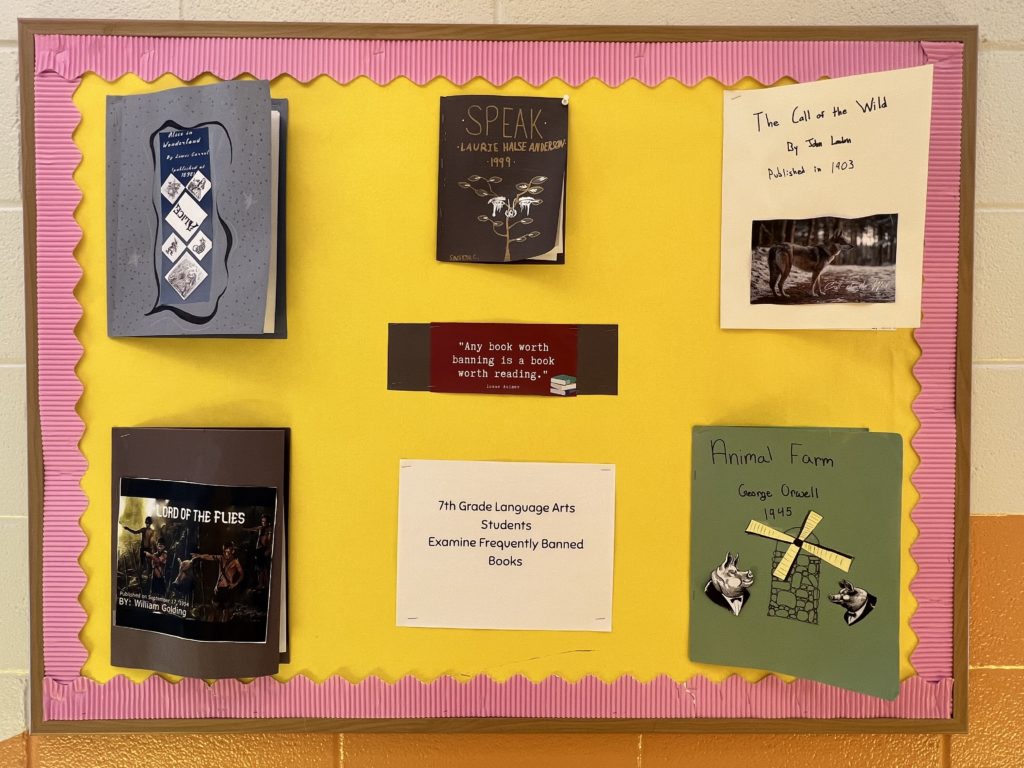
The project begins with a pile of books.
I spend an afternoon collecting volumes from various shelves in our Middle School library–science fiction, dystopia, graphic novels, modern fiction, fantasy, classics; titles that range from Bridge to Terabithia to To Kill a Mockingbird. I gather them together, and the sheer number of books makes an impressive display. Around the room, the library shelves look noticeably depleted.
At the start of the lesson, I invite my Language Arts students to look through the books, to touch them and to reflect on how many of the books they are already familiar with and how many they’re just seeing for the first time. When they sit back down, I ask them what the books have in common, looking for a particular answer. Mostly, students will give answers that relate to the genre of the books, their themes, or the fact that they belong to our library. After several minutes, I change the question. I ask them: “What if I told you that these are books that you were never, ever allowed to read? What if I told you I was gathering these books to destroy them?”
Then, very close to the pages, I light a match.
Students will gasp, scream, exclaim “No!”, sit with shock on their faces. Sometimes they’ll start to physically get up out of their chairs to come stop me. One year, a student let me know that they would hide all of the books and never let me touch them again. It usually takes a few minutes to calm them down and convince them that I really have safely put out the match, and that I promise we won’t really be harming these books.
It’s easy after that for students to name the main thing the books in the pile have in common: they have all, at some point in their history, been banned or challenged.
It is an intense lesson, one that leaves students randomly exclaiming throughout the day about the unfairness of such an unfathomable concept as banning books. I also feel it is one of the most meaningful lessons I share with students each year.
For this unit, I lead the students through unpacking some of the history and justifications behind book banning. We talk together about the era of Nazi book burnings, and look through archival imagery of children not any older than my students participating in the bonfires with smiles on their faces. We examine word clouds that show the most common reasons books are banned in the US each year. Finally, students choose a banned book and spend some time researching why it has been banned and where.
Sometimes the reasons for banning seem silly or vague, such as Watership Down being banned for containing talking animals or The Lord of the Rings being banned for being “satanic.” It doesn’t take very long, though, to find books in the list like And Tango Makes Three, an illustrated children’s book which was banned for its depiction of two male penguins raising an egg together. In several schools in California, Dr. Seuss’ The Lorax has been banned because of its negative representation of the logging industry, an industry that makes up a sizable portion of California’s economy. In China, the result of citizens creating satirical depictions of China’s president, likening him to the title character in Winnie the Pooh, resulted in a ban of that story.
The more carefully you look, the more it becomes clear that book banning is about control. And while it’s easy to look back on Nazi book burnings and imagine them as a thing of the past, we cannot ignore that a conservative pastor led a book burning for “occultic” books in Mt. Juliet, Tennessee on February 2, 2022. We cannot ignore that in November of 2021, the Moms for Liberty group in New Hampshire offered a $500 bounty to any student or parent who turned in a teacher for the teaching of “‘divisive subjects,’ such as critical race theory, racism, sexism, or ‘injustice against marginalized groups.’” We cannot ignore the so-called “Don’t Say Gay” bill that recently passed in Florida that limits “when and how teachers and school staff can discuss gender and sexual orientation in the classroom.” The more carefully you look, the more it becomes clear that book banning is about silencing diverse voices and limiting what students can read, what they can learn, and how they can think.
There is active legislation across our country and in our very state of Georgia working to keep diverse books out of student hands. Book banning is a very real and current danger.
Students deserve to see themselves reflected in the books they read. They deserve the chance to learn to think for themselves, and not for the agenda of an elite few. So when our project is done, I hang up the students’ work so that others can see and learn from it.
Then, very carefully, I put the books back on the shelves.
By:
Lead Teacher and Middle School Librarian
Sources:
Gaynor, Jessie. “A Right-Wing Pastor Held a Literal Book-Burning in Tennessee Last Night.” People’s World
Gruenberg, Mark. “Aft Hits Right-Wing Bounty Offer Targeting NH Teachers.” People’s World
Hernandez, Joe. “Florida House Passes Controversial Measure Dubbed the ‘Don’t Say Gay’ Bill by Critics.” NPR